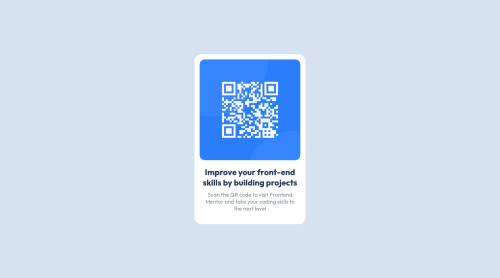simple html and css page

Please log in to post a comment
Log in with GitHubCommunity feedback
- @AdrianoEscarabote
Hi CyPhEr420, how are you? I really liked the result of your project, but I have some tips that I think you will enjoy:
As you know this project is based only on one page component, so no h1 is needed! because we don't know if this page will have a more important component, but it's always good to prevent accessibility errors so I think it would be good for you to add an
h1in this component, besides being a good practice for when you are developing larger sites, don't worry forget abouth1.<h1 class="qr-title">Improve your front-end skills by building projects</h1>Add a padding to the body, so that the content in lower resolutions doesn't hit the edge of the screen!
The rest is great!
I hope it helps... 👍
Marked as helpful - @brwmaster
Hello, Nice work! 😁
Here is a little feedback to improve the code even more
- Wrap all your code in
<main></main>tags - Change the
div class="title"> to a `<h1 class="title"> - Change the
div class="text"> to a<p class="text"> or just style the<p></p>` - Add a . to the end of the alt text to improve Accessibility
And some advice I got on my solution is to change all the
pxvalues toremvalues. link hereI hope this feedback will help you!
Marked as helpful - Wrap all your code in
- @denielden
Hello, You have done a good work! 😁
Some little tips to improve your code:
- add
maintag and wrap the card for improve the Accessibility - also you can use
articletag instead of a simpledivto the container card for improve the Accessibility - use
min-height: 100vhto body instead ofheight, otherwise the content is cut off when the browser height is less than the content - instead of using
pxuse relative units of measurement likerem-> read here
Keep learning how to code with your amazing solutions to challenges.
Hope this help 😉 and Happy coding!
Marked as helpful - add
Join our Discord community
Join thousands of Frontend Mentor community members taking the challenges, sharing resources, helping each other, and chatting about all things front-end!
Join our Discord